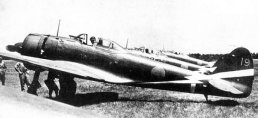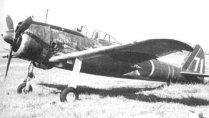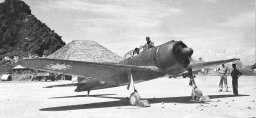
Nakajima Ki-43 Hayabusa Oscar
Named Hayabusa (peregrine falcon) by the Japanese army, the Ki-43 was ordered in December 1937 as a replacement for the Ki-27 'Nate'. The aircraft had a retracting undercarriage, but its performance was not much better than that of the earlier fighter. Even so, the Hayabusa was more than a match for the Allied fighters in the early stages of the Pacific War and in terms of numbers it became the Imperial Army's most important fighter.
With a top speed of less than 500 kmh (310 mph) and armed with only a pair of light 7.7 mm (0.303 cal) machine-guns, the Ki-43-I-Hei was almost obsolete by the time it entered service in 1941. It was highly agile, though and the 40 in service by December of that year faced little opposition during the invasions of Burma and Malaya.
Most powerful engines improved performance, however, and the Ki-43-II-Ko was used widely as a fighter-bomber, carrying a 250 kgs (550 lbs) bomb under each wing. In September 1943 the Allies captured several damaged 'Oscars' on an airfield in New Guinea. They were able to build a complete example from the wreckage and after testing it they worked out how to counter its outstanding low-speed manoeuvrability.
But its replacement, the P-51 Mustang-beating Ki-84, was late and the more powerful Ki-43-III-Ko had to remain in production until the end of the war. Nearly 6000 Ki-43s had been completed by then and the Hayabusa was still in widespread service, even though it was clearly outclassed by the modern fighters it faced. One of the Hayabusa's last roles was as a kamikaze aircraft, frequently loaded up with underwing bombs for additional effect.
 |
 |
 |
| Like many fighter aircraft of the day, the Hayabusa required mechanical starting. The Sakae radial engine was one of the plane's best features. |
Although it was capable performer in 1941, the Hayabusa was not in the same league as later Allied fighters and losses were very high in 1944. |
The Allies tested a Hayabusa and discovered its lack of armour protection and limited armament. In many ways the Ki-43 was a poor performer but it could outmanoeuvre most Allied fighters. |
|
Nakajima Ki-43 Hayabusa Oscar (Technical Specification) |
| Role |
Single-seat land-based radial-engined interceptor fighter |
| Manufacturer |
Nakajima |
| Maximum Speed |
530 kmh (329 mph) |
| Maximum Range |
1,760 km (1,090 miles) |
| Ceiling |
11,200 meters (36,750 feet) |
Weight
Empty
Maximum Takeoff |
1,910 kg (4,202 lbs)
2,925 kg (6,435 lbs) |
Dimensions
Wingspan
Length
Height
Wing Area |
10.84 meters (35 ft 6 in)
8.92 meters (29 ft 3 in)
3.27 meters (10 ft 9 in)
21.40 square meters (230 sq ft) |
| Engines |
One Nakajima Ha-115 radial piston engine which provides 858-kW (1,150 hp) |
| Armament |
Two 12.7 mm (0.50 cal) machine guns
Two 250 kgs (550 lbs) bombs underwing |
Photo Gallery
Click here to submit your photo
| Have A Passion For Aircraft? |
Subscribe to our 14 series FREE newsletter
delivered weekly on World War 2 Aircraft factfile... |
| NB:- We hate spam as much as you do, so your email address will NEVER be shared with or sold to anyone else. That's a Guarantee. |
|
|





